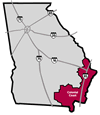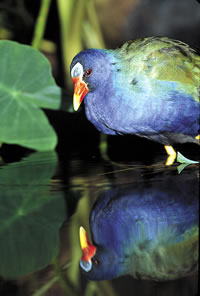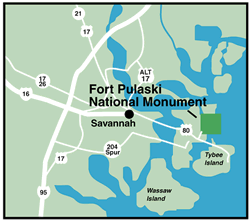
Wildlife Viewing Guide


|
Wildlife Viewing Guide |
 |
 Fort
Pulaski National Monument
Fort
Pulaski National Monument
 Description:
Named for a celebrated soldier in the American Revolution, this old fort provides
an imposing view of 5,200 acres of coastal salt marsh and 300 acres of upland
habitat located in the mouth of the giant Savannah River. Moving from the river's
edge upland you encounter bands of cordgrass, salt grass, and needle rush, the
dominant plant species of this area. Virtually all of theplants are subjected
to twice-daily tidal flooding. The small upland area is associated with the
grounds of the old fort and consists of maintained lawns and maritime forest.
Live oaks, laurel oaks, yaupon holly, and saw palmetto dominate these maritime
forests.
Description:
Named for a celebrated soldier in the American Revolution, this old fort provides
an imposing view of 5,200 acres of coastal salt marsh and 300 acres of upland
habitat located in the mouth of the giant Savannah River. Moving from the river's
edge upland you encounter bands of cordgrass, salt grass, and needle rush, the
dominant plant species of this area. Virtually all of theplants are subjected
to twice-daily tidal flooding. The small upland area is associated with the
grounds of the old fort and consists of maintained lawns and maritime forest.
Live oaks, laurel oaks, yaupon holly, and saw palmetto dominate these maritime
forests.
Viewing Information: The broad expanses of easily accessible salt marsh
make this an excellent site for viewing shorebirds, wading birds, and soaring
birds. Herons, egrets, gulls, sandpipers, and plovers are numerous throughout
the National Monument area. Wood storks are occasionally seen feeding in small
drying ponds in the area. The small isolated patches of maritime forest offer
refuge to many migratory songbirds in spring and fall. Numerous species of warblers,
swallows, and large flocks of cedar waxwings are common in the spring. Forest
mammals are surprisingly numerous and include white-tailed deer, bobcats, gray
foxes, raccoons, opossums and marsh rabbits.  Although
a wide variety of reptiles make their homes on monument grounds, they are rarely
observed. The secretive eastern diamondback rattlesnake is seen on occasion.
The American alligator is sometimes observed in the warmer months, particularly
during dry periods, when it may seek the freshwater of the fort's moat. The
Atlantic bottle-nosed dolphin is commonly sighted in the Savannah River nearby.
An old railroad, nature trail, and constructed dikes make foot travel easy around
this area and create opportunities for wildlife watching in solitude. Interpretive
programs are available.
Although
a wide variety of reptiles make their homes on monument grounds, they are rarely
observed. The secretive eastern diamondback rattlesnake is seen on occasion.
The American alligator is sometimes observed in the warmer months, particularly
during dry periods, when it may seek the freshwater of the fort's moat. The
Atlantic bottle-nosed dolphin is commonly sighted in the Savannah River nearby.
An old railroad, nature trail, and constructed dikes make foot travel easy around
this area and create opportunities for wildlife watching in solitude. Interpretive
programs are available.
Directions: From Savannah, travel 15 miles east on US Hwy. 80 and follow the signs.
Management: National Park Service, 912-786-5787 (Visitors Center)
Closest Town: Tybee Island, GA
![]()
![]()
![]()
![]()
![]()
![]()
![]()
![]()
![]()
Read and add comments about this page